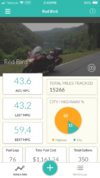Yeah - I don't make a permanent record, but I do reset the trip every time I fill up. So I can see from the fuel pump how many litres have gone in and from the trip what mileage that represents. A bit of approximate mental arithmetic - and the calculated value is always more than the displayed m/l values on the dash. Like - I could have got another 20 miles out of that tank. Which is good, 'cos if its getting marginal, there's a bit more left sloshing around the bottom of the tank that I haven't taken into account. If I start to average about 9.7 regularly - calculated at refill time - then its time to do the starter valves again.
It's worth mentioning here that there is a water drainage tube that takes rain water from around the filler cap, and routes it to an open rubber tube strapped behind the sump near the gear lever. Worth mentioning because that hole can attract muck - grits and smaller road debris, not to mention torrential downpours containing sand. It can get clogged part way down and it stays damp. And it rusts. The only metal bit of that tube is the bit that passes through the fuel - inside th tank. It emerges at the underside of the tank at the rear. Lift up the tank look backwards underneath, you will see three rubber tubes. One of them is the for the water drainage. The tube alwasy has water flowing down it when it rains. But when it stops, it will dry out. But not if there is a blockage. I frequently blast out any accumulated debris from that tube, plug the end and fill it with ACF 50 and let it stand for a while. Then drain it out.
If that tube rusts, it allows water to leak into the tank - but more crucially it allows fuel to seep into the rubber tube and escape more or less un-noticed.

